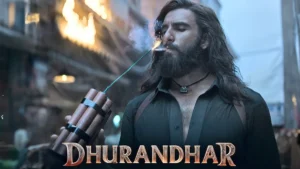Did You Catch Them? 5 Big Easter Eggs You Missed in ‘Thamma’
For fans of this shared universe, watching ‘Thamma’ is like a treasure hunt. Did You Catch Them? 5 Big Easter Eggs You Missed in ‘Thamma’

New Delhi, Saturday, October 25, 2025: The film ‘Thamma’ has hit the screens and become a huge topic of conversation. This movie is the latest addition to the popular Maddock Horror Comedy Universe (MHCU). This is the same universe that gave us blockbusters like ‘Stree’, ‘Bhediya’, and ‘Munjya’.
5 Easter Eggs You Missed in ‘Thamma’
For fans of this shared universe, watching ‘Thamma’ is like a treasure hunt. The director and writers have hidden small clues and references in the film. These are called ‘Easter Eggs’.

They link ‘Thamma’ to the past and also hint at the future of the MHCU. We have watched the movie closely to bring you the five biggest Easter Eggs you probably missed.
1. The Mighty ‘Bhediya’ Cameo and Its Deep Meaning
The most exciting moment for many fans was the appearance of Varun Dhawan as Bhaskar, or Bhediya. This was not just a fun cameo. It was a crucial part of the story.

In the film, Bhaskar (Bhediya) is seriously hurt after fighting ‘Sar Kata’ (a villain from Stree 2). Bhaskar’s cousin, Jana, is looking for a cure. He meets the exorcist Elvis Karim Prabhakar. Elvis tells him that the Bhediya needs the blood of a Betaal (vampire) to fully heal and transform.
The showdown between Ayushmann Khurrana’s character, Alok (the new Betaal), and Bhediya is a major plot point.
Bhediya drinking Alok’s blood is not just a fight. It shows that the two main creatures of the universe—the werewolf (Bhediya) and the vampire (Betaal)—are connected. It sets the stage for a much larger, combined story in future movies. This scene is the ‘Avengers moment’ for the MHCU.
2. Jana’s Humorous Reference to ‘Bittu’
Abhishek Banerjee returns as Jana from ‘Stree’ and ‘Bhediya’. He is always looking for a solution to his friend Bhaskar’s Bhediya problem. When Jana is speaking to Elvis Karim Prabhakar, he comes across Alok (Ayushmann Khurrana).
Jana calls Alok by the nickname ‘Bittu’. This is a small, funny detail. For many, it’s just a random name. But for those who know the actors, this is a clear inside joke.
In real life, the famous actor Aparshakti Khurrana, who is Ayushmann Khurrana’s brother, is often called ‘Bittu’ by his close friends. This simple one-liner directly connects the actors’ real lives to the film’s universe, making fans smile.
3. The Comeback of ‘Sar Kata’
Towards the end of ‘Thamma’, we see the evil Yakshasan (Nawazuddin Siddiqui) getting rescued. Who saves him? It is a character known as ‘Sar Kata’ (a headless creature). This character was first seen in ‘Stree’ and then in ‘Stree 2’.

This small appearance has a huge meaning. It hints that two powerful villains—Yakshasan, the former King of Betaals, and Sar Kata, the menacing creature from the ‘Stree’ world—will form an alliance.
This alliance will be a major threat in upcoming films. It shows that the heroes of the MHCU, like Stree, Bhediya, and the new Thamma (Alok), will have to team up to fight a combined enemy.
4. Introduction to ‘Shakti Shalini’
The most important Easter egg is about the next movie in the universe. In a post-credits scene, a new character is introduced. The title of the next film is revealed as ‘Shakti Shalini’.
This character is described as the ‘protector, destroyer, and the mother of all’. This new hero will be played by the young star Aneet Padda. By giving her such a powerful description, the movie hints that ‘Shakti Shalini’ will be even more powerful than Shraddha Kapoor’s Stree.
This scene acts as a direct announcement for the next chapter of the MHCU, leaving fans thrilled about what’s to come.
5. The Vampire Ban and the Year 1947
The film provides a backstory for the Betaals. Yakshasan was imprisoned because he broke a rule. The rule was that Betaals should not drink human blood.

The film explains that this ban on drinking human blood was put in place after the year 1947. The Betaal community decided this after seeing the horrors and bloodshed of the Partition of India. They felt that human blood was becoming ‘poisoned’ with such evil acts.
This is a very clever way to use a major historical event of India in a horror-comedy plot. It gives a deep, emotional reason for the supernatural rules. It also connects the Betaal story to a painful, but real, chapter of Indian history.
You May Have Missed
Join BoxOfficeWala
Get Box Office Updates Directly on Whatsapp from Your Personal Box Office Insider



Leave a Reply